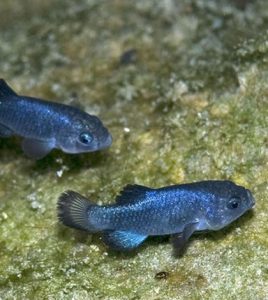Genetic History Of Devils Hole Pupfish
Besides its peculiar name, the Devils Hole Pupfish is a pretty peculiar fish. Just consider some of its key traits: large eyes, missing pelvic fins and reduced aggression behaviors. But how did this tiny little fish that inhabits a single spring cavern in the Mojave Desert in Nevada get to be so weird?
According to scientists at the University of North Carolina, it may all have to do with breeding. Chiefly, the pupfish, which has evolved in relative isolation, may very well have some inbreeding in its family tree.
Researchers have for some time thought that Devils Hole Pupfish have been isolated in a flooded cavern amidst the Mojave’s desolate landscape (Devils Hole). Their guess was that the fish had been stuck in the same spot for about 13,000 years. That would line up well with the time that a major flood is thought to have swept through the region and carried the pupfish to the cavern that they call home.
But the U. of North Carolina scientists have found that this estimate is likely much too expansive, and that the real length of time that pupfish have been stuck in the same spot by themselves really probably ranges somewhere between 105 and 830 years. From that point, the researchers say, the Devils Hole Pupfish has continued to exchange genes with other pupfish species when possible, every hundred years or so, when a new species makes it to the secluded cavern somehow.
Researchers say such moves can happen if fish eggs get stuck to a bird’s feet and transported. Or there are other ways that fish can simply move over the ground, such as through flopping or by making the journey with the help of flood waters.
To investigate the history of these pupfish, scientists built a family tree of different pupfish species using their DNA. From there, it was a matter of figuring out the timelines of when certain pupfish species split off of other ones that came before. Geological evidence played a big hand in making those determinations possible.
Scientists were able to look at the Lake Chichancanab basin in Mexico’s Yucatan Peninsula for guidance, because that region is home to several species of pupfish though none were there 8,000 years in the past. This allowed for analyzing how each species diverged from its common ancestor.
The results of the work show that DNA mutation rates in pupfish can be much higher than was once thought, backing up the notion that Devils Hole Pupfish haven’t been isolated that long.
Researchers say that the short evolution timeframes they charted were remarkable. And since mutation rates were high over a short period of time, they put forth that some pupfish species are likely much younger than expected.
One thing to note about the analysis is that it assumes that the Yucatan Peninsula was completely dry 8,000 years ago. It is possible that pupfish could have survived in patches of surface water throughout the region, given the fish’s fortitude in the present. Devils Hole Pupfish can, after all, survive in a hole that gets no direct sunlight for two months of the year and in waters that maintain a perfect 32 degrees Celsius (89 Fahrenheit) year round.

Top image: The inch-long Devils Hole Pupfish. (Credit: Olin Feuerbacher / U.S. Fish and Wildlife Service)

0 comments